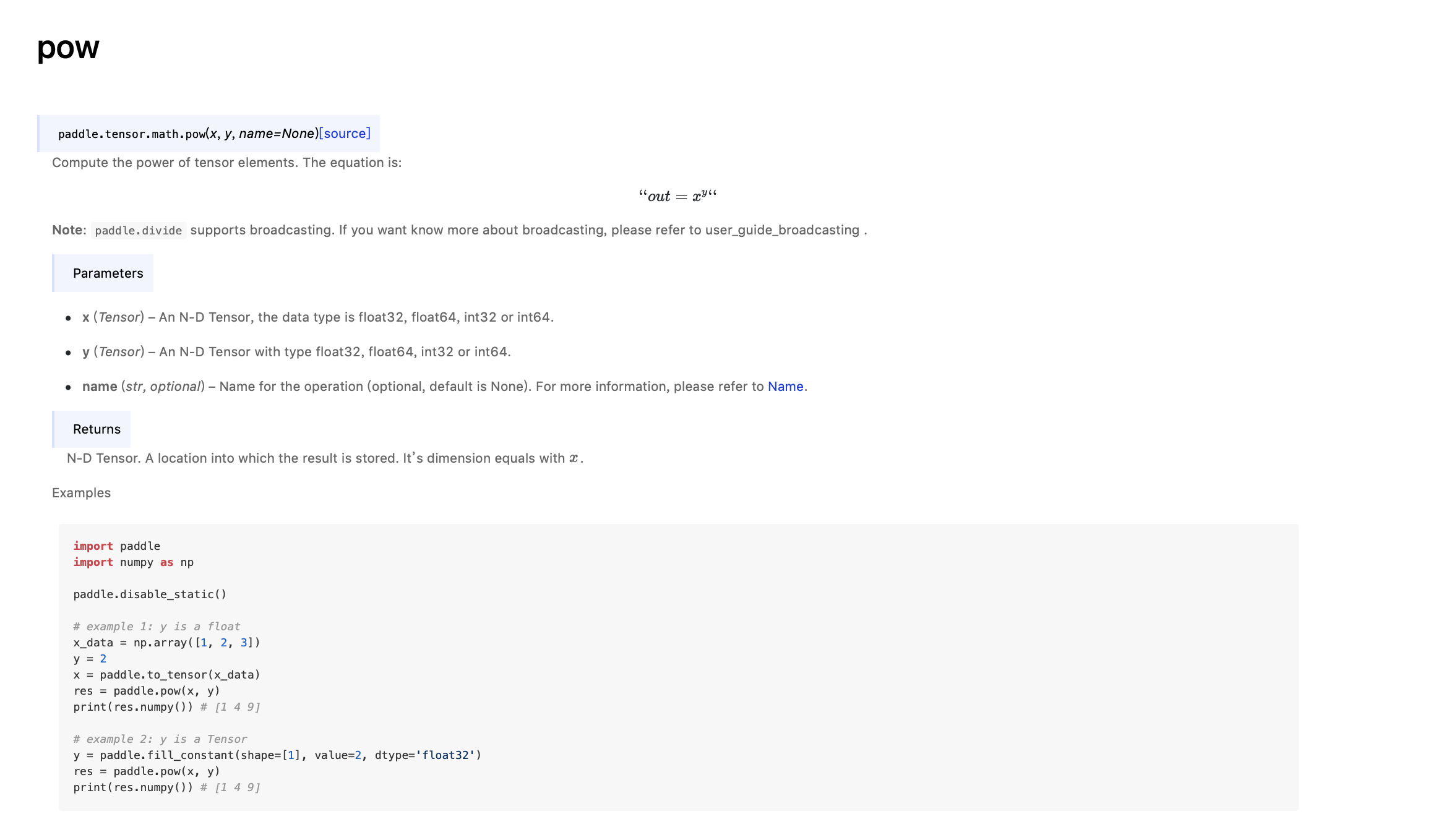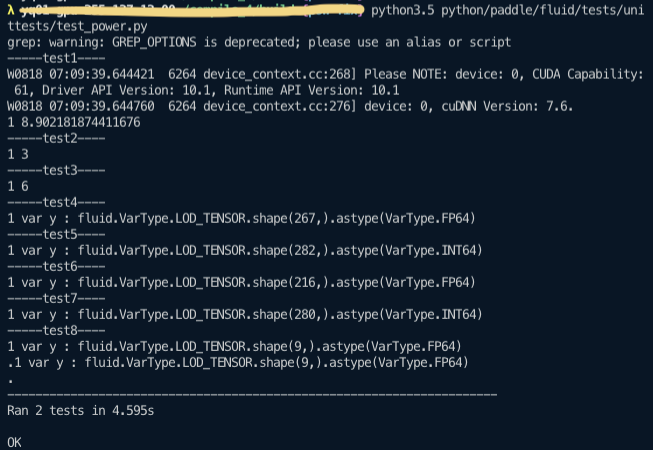Created by: Joejiong
PR types
Function optimization
PR changes
OPs
Describe
- 合并 elementwise_pow 和 pow,命名为 pow,完全兼容elementwise_pow 和 pow。
- 修复Power 函数动静态图支持float64<-pow(int64, float64)
- Power 函数动静态图支持float64<-pow(float64, int64)
- 兼容直接输入python type(float, int),与 paddle data type(Variable和Tensor)
文档预览:
测试代码:
from __future__ import print_function
import paddle
import paddle.tensor as tensor
import paddle.fluid as fluid
from paddle.static import Program, program_guard
import numpy as np
import unittest
DYNAMIC = 1
STATIC = 2
def _run_power(mode, x, y):
# dynamic mode
if mode == DYNAMIC:
paddle.disable_static()
# y is scalar
if isinstance(y, (int, float)):
x_ = paddle.to_tensor(x)
# print(x_)
y_ = y
res = paddle.pow(x_, y_)
return res.numpy()
# y is tensor
else:
x_ = paddle.to_tensor(x)
y_ = paddle.to_tensor(y)
res = paddle.pow(x_, y_)
return res.numpy()
# static mode
elif mode == STATIC:
paddle.enable_static()
# y is scalar
if isinstance(y, (int, float)):
with program_guard(Program(), Program()):
x_ = paddle.data(name="x", shape=x.shape, dtype=x.dtype)
y_ = y
res = paddle.pow(x_, y_)
place = fluid.CPUPlace()
exe = fluid.Executor(place)
outs = exe.run(feed={'x': x}, fetch_list=[res])
return outs[0]
# y is tensor
else:
with program_guard(Program(), Program()):
x_ = paddle.data(name="x", shape=x.shape, dtype=x.dtype)
y_ = paddle.data(name="y", shape=y.shape, dtype=y.dtype)
res = paddle.pow(x_, y_)
place = fluid.CPUPlace()
exe = fluid.Executor(place)
outs = exe.run(feed={'x': x, 'y': y}, fetch_list=[res])
return outs[0]
class TestPowerAPI(unittest.TestCase):
"""TestPowerAPI."""
def test_power(self):
"""test_power."""
np.random.seed(7)
# test 1-d float tensor ** float scalar
dims = (np.random.randint(200, 300), )
x = (np.random.rand(*dims) * 10).astype(np.float64)
y = np.random.rand() * 10
res = _run_power(DYNAMIC, x, y)
self.assertTrue(np.allclose(res, np.power(x, y)))
res = _run_power(STATIC, x, y)
self.assertTrue(np.allclose(res, np.power(x, y)))
# test 1-d float tensor ** int scalar
dims = (np.random.randint(200, 300), )
x = (np.random.rand(*dims) * 10).astype(np.float64)
y = int(np.random.rand() * 10)
res = _run_power(DYNAMIC, x, y)
self.assertTrue(np.allclose(res, np.power(x, y)))
res = _run_power(STATIC, x, y)
self.assertTrue(np.allclose(res, np.power(x, y)))
x = (np.random.rand(*dims) * 10).astype(np.int64)
y = int(np.random.rand() * 10)
res = _run_power(DYNAMIC, x, y)
self.assertTrue(np.allclose(res, np.power(x, y)))
res = _run_power(STATIC, x, y)
self.assertTrue(np.allclose(res, np.power(x, y)))
# test 1-d float tensor ** 1-d float tensor
dims = (np.random.randint(200, 300), )
x = (np.random.rand(*dims) * 10).astype(np.float64)
y = (np.random.rand(*dims) * 10).astype(np.float64)
res = _run_power(DYNAMIC, x, y)
self.assertTrue(np.allclose(res, np.power(x, y)))
res = _run_power(STATIC, x, y)
self.assertTrue(np.allclose(res, np.power(x, y)))
# test 1-d float tensor ** 1-d int tensor
dims = (np.random.randint(200, 300), )
x = (np.random.rand(*dims) * 10).astype(np.float64)
y = (np.random.rand(*dims) * 10).astype(np.int64)
res = _run_power(DYNAMIC, x, y)
self.assertTrue(np.allclose(res, np.power(x, y)))
res = _run_power(STATIC, x, y)
self.assertTrue(np.allclose(res, np.power(x, y)))
# test 1-d int tensor ** 1-d float tensor
dims = (np.random.randint(200, 300), )
x = (np.random.rand(*dims) * 10).astype(np.int64)
y = (np.random.rand(*dims) * 10).astype(np.float64)
# print(np.power(x, y))
res = _run_power(DYNAMIC, x, y)
self.assertTrue(np.allclose(res, np.power(x, y)))
res = _run_power(STATIC, x, y)
self.assertTrue(np.allclose(res, np.power(x, y)))
# test 1-d int tensor ** 1-d int tensor
dims = (np.random.randint(200, 300), )
x = (np.random.rand(*dims) * 10).astype(np.int64)
y = (np.random.rand(*dims) * 10).astype(np.int64)
res = _run_power(DYNAMIC, x, y)
self.assertTrue(np.allclose(res, np.power(x, y)))
res = _run_power(STATIC, x, y)
self.assertTrue(np.allclose(res, np.power(x, y)))
# test 1-d int tensor ** 1-d int tensor
dims = (np.random.randint(200, 300), )
x = (np.random.rand(*dims) * 10).astype(np.int32)
y = (np.random.rand(*dims) * 10).astype(np.int32)
res = _run_power(DYNAMIC, x, y)
self.assertTrue(np.allclose(res, np.power(x, y)))
res = _run_power(STATIC, x, y)
self.assertTrue(np.allclose(res, np.power(x, y)))
# test 1-d int tensor ** 1-d int tensor
dims = (np.random.randint(200, 300), )
x = (np.random.rand(*dims) * 10).astype(np.float32)
y = (np.random.rand(*dims) * 10).astype(np.float32)
res = _run_power(DYNAMIC, x, y)
self.assertTrue(np.allclose(res, np.power(x, y)))
res = _run_power(STATIC, x, y)
self.assertTrue(np.allclose(res, np.power(x, y)))
# test 1-d int tensor ** 1-d int tensor
dims = (np.random.randint(200, 300), )
x = (np.random.rand(*dims) * 10).astype(np.float64)
y = (np.random.rand(*dims) * 10).astype(np.float32)
res = _run_power(DYNAMIC, x, y)
self.assertTrue(np.allclose(res, np.power(x, y)))
res = _run_power(STATIC, x, y)
self.assertTrue(np.allclose(res, np.power(x, y)))
# test 1-d int tensor ** 1-d int tensor
dims = (np.random.randint(200, 300), )
x = (np.random.rand(*dims) * 10).astype(np.float64)
y = (np.random.rand(*dims) * 10).astype(np.int32)
res = _run_power(DYNAMIC, x, y)
self.assertTrue(np.allclose(res, np.power(x, y)))
res = _run_power(STATIC, x, y)
self.assertTrue(np.allclose(res, np.power(x, y)))
# test 1-d int tensor ** 1-d int tensor
dims = (np.random.randint(200, 300), )
x = (np.random.rand(*dims) * 10).astype(np.float32)
y = (np.random.rand(*dims) * 10).astype(np.int64)
res = _run_power(DYNAMIC, x, y)
self.assertTrue(np.allclose(res, np.power(x, y)))
res = _run_power(STATIC, x, y)
self.assertTrue(np.allclose(res, np.power(x, y)))
# test broadcast
dims = (np.random.randint(1, 10), np.random.randint(5, 10),
np.random.randint(5, 10))
x = (np.random.rand(*dims) * 10).astype(np.float64)
y = (np.random.rand(dims[-1]) * 10).astype(np.float64)
res = _run_power(DYNAMIC, x, y)
self.assertTrue(np.allclose(res, np.power(x, y)))
res = _run_power(STATIC, x, y)
self.assertTrue(np.allclose(res, np.power(x, y)))
class TestPowerError(unittest.TestCase):
"""TestPowerError."""
def test_errors(self):
"""test_errors."""
np.random.seed(7)
# test dynamic computation graph: inputs must be broadcastable
dims = (np.random.randint(1, 10), np.random.randint(5, 10),
np.random.randint(5, 10))
x = (np.random.rand(*dims) * 10).astype(np.float64)
y = (np.random.rand(dims[-1] + 1) * 10).astype(np.float64)
self.assertRaises(fluid.core.EnforceNotMet, _run_power, DYNAMIC, x, y)
self.assertRaises(fluid.core.EnforceNotMet, _run_power, STATIC, x, y)
# test dynamic computation graph: inputs must be broadcastable
dims = (np.random.randint(1, 10), np.random.randint(5, 10),
np.random.randint(5, 10))
x = (np.random.rand(*dims) * 10).astype(np.float64)
y = (np.random.rand(dims[-1] + 1) * 10).astype(np.int8)
self.assertRaises(TypeError, paddle.pow, x, y)
if __name__ == '__main__':
unittest.main()
输出:


